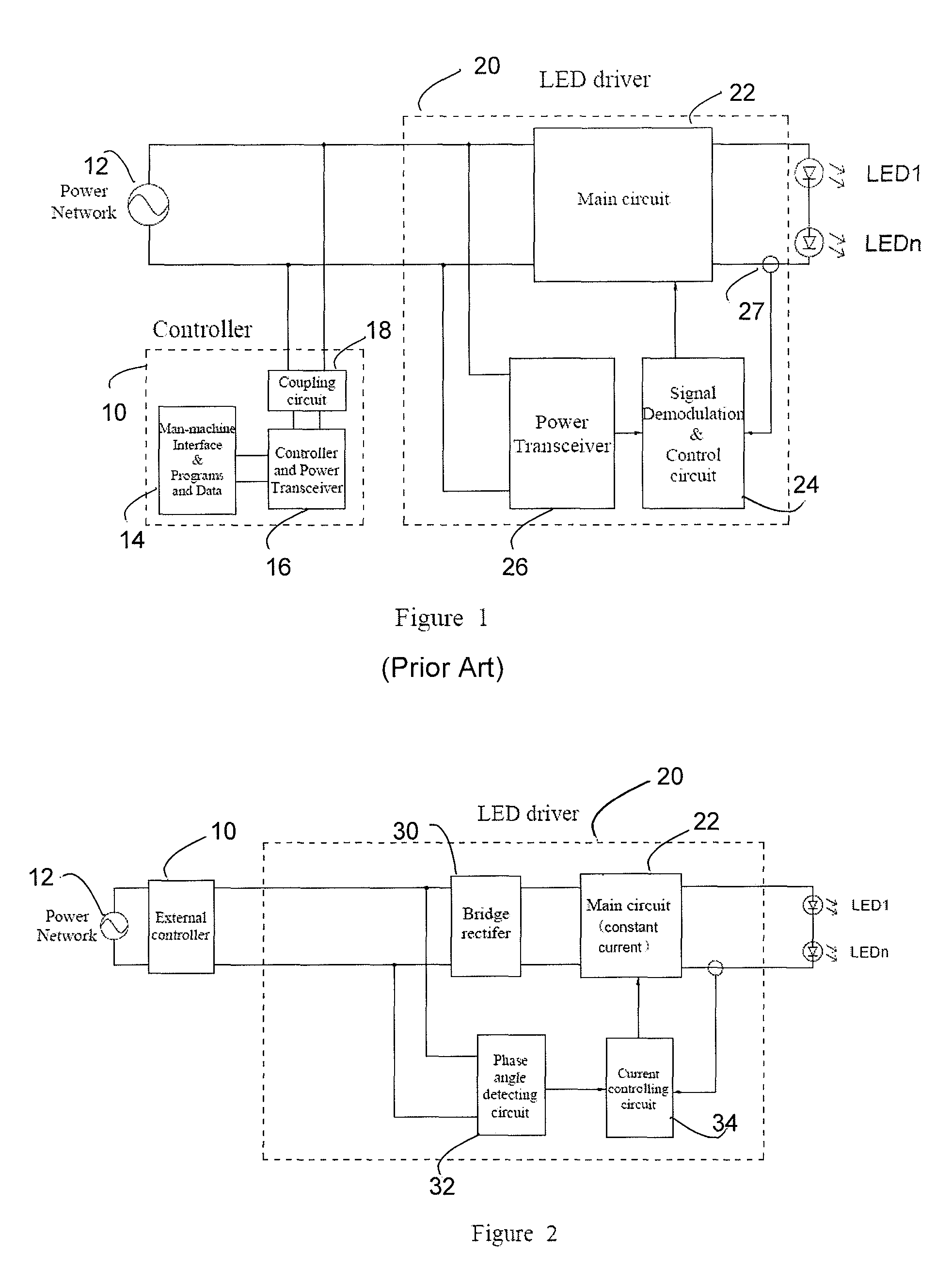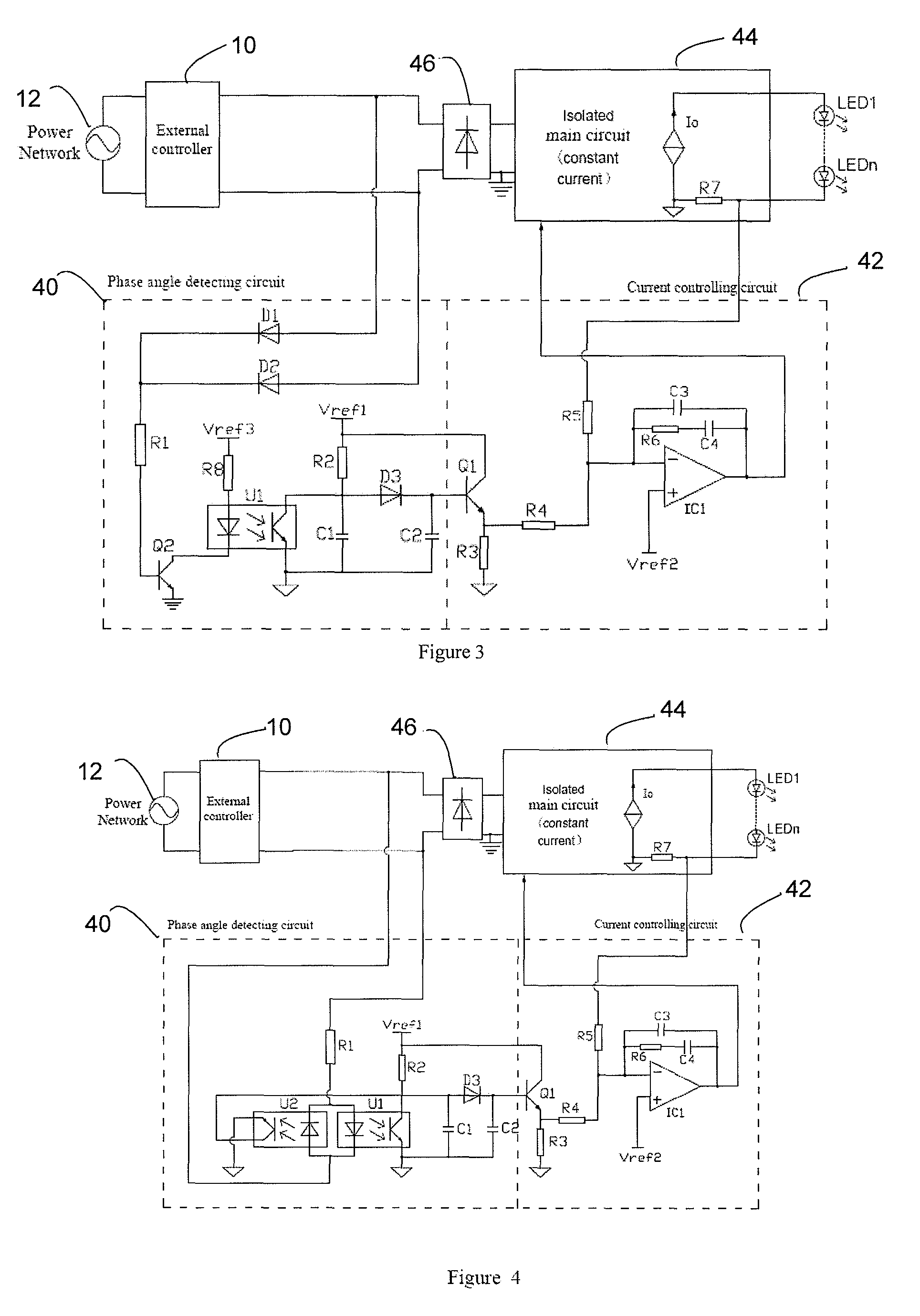LED drive circuit for SCR dimming
a drive circuit and dimming technology, applied in the direction of static indicating devices, instruments, semiconductor lamp usage, etc., can solve the problems of low reliability, complex circuitry, and inability to achieve the purpose of illumination intensity adjustment, etc., to achieve good dimming effect, simple structure, and low cost
- Summary
- Abstract
- Description
- Claims
- Application Information
AI Technical Summary
Benefits of technology
Problems solved by technology
Method used
Image
Examples
first embodiment
[0023]In FIG. 3, the first embodiment comprises an isolated phase angle detecting circuit and an isolated current controlling circuit, and an isolated main circuit with constant current output. The input of the external controller is the power network, and the output of the external controller is the input of the bridge rectifier and the phase angle detecting circuit.
[0024]The phase angle detecting circuit consists of resistor R1, resistor R2, resistor R8, capacitor C1, capacitor C2, diode D1, diode D2, diode D3, transistors Q2 and optocoupler U1.
[0025]The anodes of D1 and D2 are connected to the two output ends of the external controller respectively. The cathodes of D1 and D2, and one end of R1 are connected. The other end of R1 is connected to the base of Q2, while the emitter of Q2 is connected to the power ground. The cathode of the LED in U1 is connected to the collector of Q2, while the anode of U1 is connected to one end of R8. The other end of R8 is connected to the Vref3 e...
second embodiment
[0028]In FIG. 4, the second embodiment comprises an isolated phase angle detecting circuit, an isolated current controlling circuit, and an isolated main circuit with constant current output. The input of the external controller is power network, and the output of which is the input from the bridge rectifier and the phase angle detecting circuit.
[0029]The phase angle detecting circuit consists of resistor R1, resistor R2, capacitor C1, capacitor C2, diode D3, transistors Q1, optocoupler U1 and optocoupler U2.
[0030]A branch consists of the LEDs in U1 and U2 using an anti-parallel connection, and R1 in series. The two ends of the branch are connected to the two output ends of the external controller respectively. The collectors of the photistors in U1 and U2 are connected together, and then connected to the anode of D3, the ends of R2 and C1. The other end of R2 is connected to the Vref1 end of the second reference power supply. The emitters of photistors in U1 and U2 are connected to...
third embodiment
[0033]In FIG. 5, the third embodiment comprises an isolated phase angle detecting circuit and an isolated current controlling circuit use isolated circuit, and an isolated main circuit with constant current output. The input of the external controller is power network, and the output of the external controller is the input of the bridge rectifier and the phase angle detecting circuit.
[0034]The phase angle detecting circuit consists of resistor R1, resistor R2, capacitor C1, capacitor C2, diode D1, diode D2, diode D3, optocoupler U1.
[0035]The anodes of D1 and D2 are connected to the two output ends of the external controller respectively. The cathodes of D1 and D2, and one end of R1 are connected. The other end of R1 is connected to the anode of the LED in U1. The cathode of the LED in U1 is connected to the power ground. The collector of the photistor in U1 is connected to the anode of D3, one end each of R2 and C1. The other end of R2 is connected to the Vref1 end of the first refe...
PUM
 Login to View More
Login to View More Abstract
Description
Claims
Application Information
 Login to View More
Login to View More - R&D
- Intellectual Property
- Life Sciences
- Materials
- Tech Scout
- Unparalleled Data Quality
- Higher Quality Content
- 60% Fewer Hallucinations
Browse by: Latest US Patents, China's latest patents, Technical Efficacy Thesaurus, Application Domain, Technology Topic, Popular Technical Reports.
© 2025 PatSnap. All rights reserved.Legal|Privacy policy|Modern Slavery Act Transparency Statement|Sitemap|About US| Contact US: help@patsnap.com



